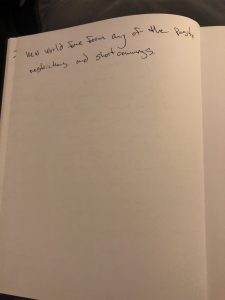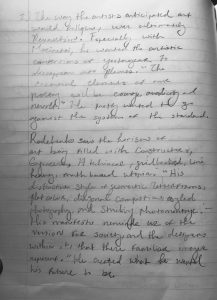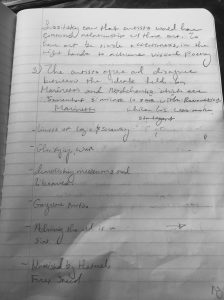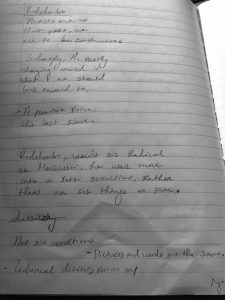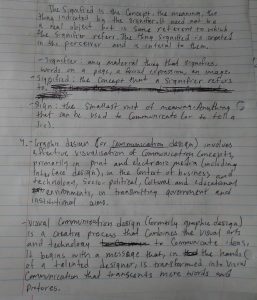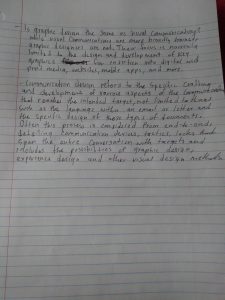Year: 2019
Carmen Diaz
Monica Jeune Sep23 Manifestos
Dennis U. September 23
- From what I readied I believe that each of the authors had their own way to improve art. For example, one had to used art in a book cover so that it can grab people to see what’s about. After all, it was help with technology to make that possible and with this the idea of art improve with technology. As for the other author I didn’t get much until the end when it talks about futurism. The author made a list that seems like an event or something to related to futurism. In this article it say’s “ 10. We want to demolish museums and libraries, fight morality, feminism and all opportunist and utilitarian cowardice.” From what a read using futurism in art can send a message saying what’s going or that this might happen later on. Lastly the last article is a poem but it seems like it talk about the change it is going on I think. I will say that in the beginning was it say’s that the process and goes on with other technology mention. However, from what I get that sense time is changing even art can change.
- How these authors anticipated how art would change and explain in their own articles. For example, the word futurism is one of them because it talks about war and other action. After all, there was design in art to support the cause in different scenario. As for how the technology help it shows that art doesn’t only have to be drawn it can work with technology. However, most them involved with change that it’s not going to stop and see how this change can be good for art.
- I believe that these ides where the author thinks about art intersect and where it might go. For example, one of the author talk about technology it talks about how it changes and now it is still changing. Also, how this diverges is the computers because now the artist used programs to help with digital art. However, technology is still changing and don’t know what else can change with digital art maybe virtual. As for one that talk about futurism that’s an idea that will go on no matter what because change is going to happen. With this people will diverge this change because people think what can change and how can it help the world of art or something else, Overall, change is going to happen like all these author talk about different ideas that is what cause the change. No one has one idea there are multiple ideas that people will think because change starts with us.
Rana Abdelnaby September 23
Briefly, focusing on modernity, I can see that the 20thcentury brought with it the ideas of futuristic and constructivism in artistic movements. These authors Marinetti, El Lissitzky, and Aleksandr Rodchenko found that the old style was outdated and needed a new revolution in the field of art. I understand that there was a need to explore new ways of expressing visual art and deviate away from anything old in terms of artistic and political tradition. For example, the author expresses how images recollected from memories bring expression of the artists from the old pictures of funeral and how it rekindled painful memories that were a deterrent to the authors dream . This was to embrace originality in the artwork and incorporate expression of emotions that would easily identify with the audience. As a result, it helped in integrating technology such as architecture and photography to build art in modern society. The manifesto demanded artists to reconsider the wording, design and space of a book to give a chance for writers to embrace new method of writing . I think that El Lissitzky was talking about new way possibilities for type writing with machines, printing and copying and duplicating instead of handwriting which is tiresome and outdated form of art. Rodchenko, Stepanova & Gan Manifesto was a constructivism art movement for communism where the focus was designing new products and relying on geometric to have mass production of products in industry. I think that the manifesto found new possibilities for people to be liberated and form a new society that is equal while focusing on change from oppressing elite class.
These artists anticipated the art and design through the notion that the manifesto was meant to allow the artist to be fearless in their work. From my understanding, futuristic manifesto focused on introducing a new way of representing artists such as graphic, sculpture, and recording. I think the revolution was daring and violent as it rebelled against the excellent harmony as it dismissed the theme of the prior art while glorifying science and nature of representing information in a book. According to the manifesto I think that it provided the artist with a new agenda of not being afraid of taking a different approach in their work of art, even if it was dangerous. It argued that the artist needs to be encouraged in their work and audacity and revolt against the prevailing norms of world art.
As I read the authors work, I gained insight that the idea of Marinetti manifesto of futurism, El Lissitzky of Our Book and Manifesto of the Constructivist Group by Aleksandr Rodchenko are fueled toward integration of technology in the artist movement. The futuristic campaign aimed at embracing the new model of art and leaving away the old fashion of art. When it comes to Marinetti manifestos, I acknowledge that the ideas of futuristic intersect with El Lissitzky idea of art as an evolution and not a new start that requires innovation and embracing of modern technology to improve art in the society. Also, Aleksandr Rodchenko manifesto response is aimed to call for a response even if it is not the one that is expected or was desired but has a positive impact after all. The improvement is through the political movements that exonerate society from the bondage of the harmful or unprogressive form of life through acquiring new ways.
Glenn Compitello September 16th
Linguistics is the study of language and Semiology is the study of signs used in communication. Both usually work together but most people do get confused between the meaning of the both. Some people thought Semiology is only used in writing but it’s used in everyday life such as signs for bathrooms and road signs. I learned in the article was that the only way language can exist is from past communication systems actually working rather it being a completely new thing. Language can always takes from the past and present for it to stay around. Additionally, if a language doesn’t take from present times it can turn into a dying communication system.
Another interesting take away from the text is the idea that speech is psychological concept of ideas. This really relates to how semiology is used in communication, due to the fact that talking takes the use of social cues. Social cues are signs, I might not be as in depth as semiology in writing. In speech, when having a conversation with another. Our minds are using semiology to create thoughts psychologically.
Communication design is related to visual arts because they both use similar language and are visually aesthetic. Design is a form of visual art with its composition the only difference is the graphic design principles. Most graphic design principles are equivalent to the grammar of contrast.
Assignment for September 23
Our third reading assignment is three short manifestos written by avant-garde artists in the early decades of the 20th century. They are as follows:
Filippo Tommaso Marinetti, The Founding and Manifesto of Futurism (1909):Marinetti_Manifesto_Futurista
Aleksandr Rodchenko, Varvara Stepanova, Aleksei Gan, Who We Are: Manifesto of the Constructivist Group (c. 1922): RodchenkoStepanovaGan_WhoWeAre
El Lissitzky, Our Book (1926): Lissitsky_OurBook
Here are some questions to consider as you read:
The first decades of the 20th century brought a wave of new technologies and inspired a generation of artistic movements. What new possibilities did the authors of these manifestos find at the start of the new century? In what ways did these artists anticipate the art and design that would follow? Where might the ideas of these authors intersect? And where might they diverge?
Tracy Truong September 16th
Javion Bailey Sept 16
To be completely honest, this was a tough read for me. I felt lost while reading, and the concepts were pretty hard to grasp. But what I interpret as the difference between linguistics and semiology is that semiology is the reflection of the rules placed on different symbols, signs and words etc used in language. It governs how the words are used and their meanings. Linguistics on the other hand studies the auditory and physiology of communication between two or more people.
In addition, the author is also making the claim that linguistics is only a branch of semiology. That the system of signs is the whole in which language derives from. “A science that studies the life of signs within society.” This implies that semiology stems from society and how society perceives and uses these signs. Semiology can be used to put a value on the sociological impact of different symbols.
Studying different cultures and practices associated with them can shed more light on language. Studying linguistics on it’s own and following it’s set of rules only serve to separate it from semiology and all other things associated within society. Looking at it from the viewpoint of the individual it ignores the sociological structures. But looking at it from a social standpoint it would take the value away of the individual.
Jeremy Eisner September 16th
Semiology is the study of making signals and signs, yet some people confuse it with linguistics. Linguistics is the is the study of language and speaking itself, but a good sign does not need a language to be effective.
When you are on the road, you see certain signs that signal what to do. Maybe you will see a red sign that says stop, or a yellow sign that says yield, or another sign for making a turn. Despite these signs all having language on them, the signs themselves have become a landmark themselves. This means that the color, shape and icons on these signs have become almost universal in communicating the same message to those who see them. If something is red, you know to stop, if yellow, slow down and a bent arrow is turn. The words almost become a second thought since we already know what to do from the signals made from the sign. The idea of semiology is to create this effect, a symbol so iconic, yet easy enough for people all around the world to understand without language barriers in the way.
Linguistics find less of a place on signs, but more of a place on graphic design and poster making. Being the study of language, it’s important to know the language of the audience you want to market to. You could have a signal that lures the person in, but most of your ads will be most effective based on the way they are written. If your ad looks interesting, but is poorly written, the consumer has just wasted their time and becomes a distraction. This is similar to signs as a bad sign distracts people and confuses people into doing misinterpreted responses from the sign. Overall, it is important to know that making a good sign is one that is devoid of the forces that bound us by the common language, that have the ability to invoke an action from a mere glance.





